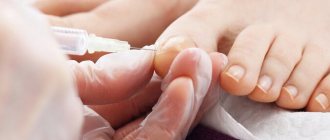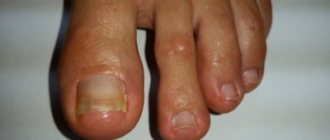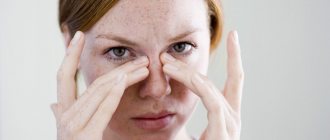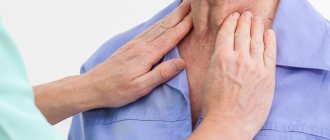Nail onycholysis is a dystrophic lesion of the nail plate, manifested in its separation from the bed while partially or completely maintaining its usual shape. Pathology develops with equal frequency on the fingers or toes. About 60% of detected cases of the disease are the consequences of injuries, up to 30% are formed under the influence of dermatomycosis. The remaining 10% are due to somatic diseases, dermatoses or pyoderma. The disease can develop in a person at any age; women are diagnosed more often than men. In case of traumatic damage to the nail, the pathology does not cause significant discomfort to the wearer; treatment is carried out for aesthetic reasons.
Reasons for development
Dermatologists distinguish three groups of causes for the development of the disease:
- injuries;
- mycoses;
- allergies.
The mechanism of development of onycholysis on the fingers is determined by the root cause of the pathology.
Traumatic injuries to the hands or feet affect the nails and nail bed. A subungual hematoma is formed between them, the vessels in the upper layers of the dermis are compressed, which leads to disruption of the nutrition of the nail, a change in its chemical composition and loss of elasticity. The plate is deformed, the connection between it and the bed weakens. Detachment occurs from the free edge. Violation of the fit increases the risk of infection and the development of inflammation. The nail root does not lose connection with the matrix. After the hematoma resolves, the plate grows as before.
Infectious onycholysis on the arms or legs occurs due to inflammation. The process includes three stages:
- alteration - pathological damage to the dermis, cells of the immune system produce cytokines and inflammatory mediators;
- exudation - disturbance of water-electrolyte balance in tissues, swelling of the nail, development of pathogenic microflora on the bed;
- proliferation - the development of hyperkeratosis of the nail bed with its subsequent deformation.
Normal growth of the nail plate begins after complete relief of the inflammatory process. Complicated onycholysis of fingernails or toenails will require the patient not only to comply with all medical prescriptions of the dermatologist, but also to follow a diet.
The allergic variant of the pathology develops according to a similar scenario to the inflammatory one. During the exudation stage, an excess amount of antibodies to pathogenic microflora is produced. This leads to increased sensitivity of the skin, increased deformation of the nail plate and the adjacent dermis. The regeneration process slows down significantly.
Structure of the nail and nail plate
Our nails are quite complex. The following illustration will help you understand their structure.
Inside the phalanx of the finger there is a thin bone (1). The nail plate (3) grows from the root of the nail (4). Matrix (5) is a special zone responsible for growth. The nail ligament (7) is located under the nail bed. In this place, the nail tissue is fused with soft tissues. The posterior nail fold (9) limits the edges of the nail, on which the eponychium (8) and cuticle are located. There are also rollers on the sides, which are called side bolsters. On the opposite side of the eponicium and cuticle is the free edge of the nail. Underneath it is the hyponychium (6) - a special fold of skin, the shape and size of which is different for each person.
Kinds
Dermatologists distinguish several main types of pathology based on the clinical picture of the disease and the cause of damage to the patient’s nail plates. The most common types of onycholysis are:
- traumatic;
- dermatological;
- endocrine;
- systemic;
- fungal;
- bacterial;
- allergic.
Traumatic lesions of the nails occur after wounds or burns to the patient’s tissues. Probable causes remain splinters, excessive physical impact, and exposure to toxic or toxic substances. Toes can be hurt when wearing tight or poorly ventilated shoes.
The dermatological type of pathology develops under the influence of dermatoses, leading to disturbances in the processes of cellular nutrition in the affected area. Endocrine onycholysis results from humoral disorders in the human body or chronic disorders of the endocrine glands.
Systemic onycholysis is caused by diseases of the human digestive tract and subsequent metabolic disorders. The condition of the patient's tissues improves significantly after eliminating the disease that is the root cause of the separation of the nails from the bed.
The fungal type of pathology is formed after the formation of colonies of microfungi in the subungual space. The subsequent change in the nail bed almost does not affect the nail itself, which remains unchanged. The disease develops as a result of a long-term mycotic infection.
The bacterial course of onycholysis is the result of the addition of a secondary infection to any type of pathology. Allergic lesions of nail tissue develop when the patient takes medications, contacts with chemicals or directed ultraviolet radiation.
Reasons why nails move away from the skin
Wearing tight shoes often leads to peeling toenails. Female representatives are more susceptible to the problem when wearing shoes with narrow toes and stiletto heels. Non-breathable shoes can cause splitting, inflammation and suppuration of the nail.
Initially, the thumb is affected; if treatment is not started, it spreads to the neighboring ones. The little finger rarely suffers, only in severe stages.
The nail begins to delaminate and deform after a procedure such as extensions. In open shoes, the nails covered with gel are not in any danger, but in closed shoes they are compressed, bent, and peeled. As a result of the accumulation of infection under the gel, the nail plate and skin are affected, and a void is formed.
The main reasons why the nail begins to move away from the skin:
- fungus;
- injuries and bruises;
- infectious diseases;
- exposure to medications;
- extension;
- aggressive influence of chemicals, including household ones;
- genetic factor.
If the nail is constantly exposed to chemicals, it can also peel off from the skin. For example, upon contact with washing powder, varnish, solvents, etc.
Onycholysis can appear on the legs along with a skin disease. The formation of emptiness can be a side effect of taking fluoroquinol and tetracycline antibiotics. After completing the course of treatment, the nail continues to grow in its natural place. It takes several months for complete recovery.
If delamination occurs only along the edge, most likely it is a fungal disease. The problem cannot be treated at home, but requires immediate medical attention.
If you do not pay attention to the problem, the plate may peel off over its entire area. If a nail falls off, then it is extremely difficult to eliminate the defect.
Symptoms on arms and legs
The clinical picture of the disease is the same for all types of pathology: the nail plate is separated from the bed from the free edge in the distal or lateral sections to the nail hole. The color of the plate changes from flesh-colored to gray-white due to air entering the subungual space. With the development of pathogenic microflora in the resulting free space, a further change in color is possible: yellow becomes the result of bacterial infections, brown - the formation of a colony of microfungi, green - damage to Pseudomonas aeruginosa.
Bacterial infections affect the structure and strength of the nail plate. The surface of the nails loses its shine, becomes rough and gradually becomes deformed. The subungual space is filled with dirt and keratin. This leads to the development of hyperkeratosis, characterized by an unpleasant odor. In advanced stages of the pathology, a focus of secondary inflammation may develop. Detachment of part of the nail is called partial onycholysis, while the entire plate is called total.
For fungal infection
Such a serious reason for the development of onycholysis as a fungal infection requires not only the use of special drugs, but also long-term treatment using folk remedies. To do this you need to show persistence and patience.
It is very beneficial to fight fungus with regular iodine. They need to lubricate the damaged nail twice a day for 20 days.
Propolis tincture
Propolis tincture (20%) can be a real salvation for this disease. It is recommended to soak the diseased nail in the solution using a tampon for 10 minutes. In just a few days, the plate will be able to move away, and a new one will grow in its place.
You should not always resort to expensive medications if problems arise with your nails; minor damage can be cured using traditional methods. But if a serious problem arises, consultation with a specialist becomes a vital necessity.
Nail care should not be limited to manicure and pedicure. Fingers will be beautiful if they are healthy. The “reference” nail is even, smooth, and pure pinkish in color. Any other color effects: grooves, white spots, etc. - all these are deviations from the norm; they are not cosmetic defects, but belong to the category of diseases.
Diseased nails have an unsightly appearance
Seeing a doctor
Detecting the first symptoms of onycholysis is a good reason to visit the clinic. Any stage of the disease requires consultation with a dermatologist. During the diagnosis and treatment of the disease, the patient may require the opinions of other specialists: an endocrinologist, a surgeon, a therapist.
Ignoring the symptoms of pathology can lead to multiple damage to the nail plates on the patient’s hands and feet, the formation of numerous foci of infection and damage to other tissues and systems of the body.
Are you experiencing symptoms of onycholysis?
Only a doctor can accurately diagnose the disease. Don't delay your consultation - call
Prevention methods
To reduce the risk of re-infection, you must follow simple rules:
- When visiting public places, you must wear rubber slippers.
- You cannot try on or walk in someone else's shoes.
- Do not use someone else's towel or manicure accessories without treatment.
- Inspect your skin and nails regularly; if the first symptoms appear, you should consult a doctor.
- Boots and shoes should be made from natural materials, appropriate for the season, and not cause discomfort when worn.
- Change socks or tights as they become dirty.
- Use preventative varnishes that protect the nail plate from external influences.
- After the bath, dry your feet, especially the spaces between your toes.
- To prevent dryness, apply moisturizer to your feet.
It is quite easy to protect yourself from the fungus that causes onycholysis: if you suspect an illness, do not delay the process and get examined.
Diagnostics on legs and arms
The diagnosis is made during a visual examination of the patient by a dermatologist. The development of onycholysis is preceded by damage to the nail plates by Bo lines, which occur against the background of damage to the nail matrix. This sign indicates systematic injuries or the presence of somatic pathologies.
A mandatory stage of clinical tests is obtaining scrapings from damaged tissues to conduct laboratory tests and exclude mycotic lesions of the nail and nail bed. Differential diagnosis of onycholysis is carried out with mycoses, psoriasis, lichen planus, Bowen's disease and onychodystrophies of unknown etiology.
Different types of onycholysis on the fingers or toes will require in-depth analyzes to establish the causes of the development of pathology with multiple clinical pictures. The reason for this is the variety of colors of the nail plates, visible differences in their structure, transparency, and area of hyperkeratotic layering.
How to treat a growth under the nail?
If you carefully read the first part of the article, you already realized that treatment methods will greatly depend on the cause of the growth under the nail. For fungal diseases, special medications may be prescribed; ingrown nails and periungual warts are most often removed. Treatment is prescribed only by a dermatologist or surgeon after an external examination and passing the necessary tests (scraping to exclude or confirm the fungus).
Even if a splinter gets in, which can also cause a skin growth to appear near the nail, it is best to contact a surgeon who will remove it in compliance with all disinfection rules. If the growths are accompanied by severe pain, then you can apply a bandage with alcohol or Vishnevsky ointment to the affected area. Just remember that this is not a treatment option - it is better to immediately seek help from a doctor!
( 1 ratings, average: 5.00 out of 5)
Treatment of nail onycholysis
Pathology requires complex therapy. The key task is to treat the underlying disease against which onycholysis of the nails develops. The allergic type of damage to the nail plate requires consultation of the patient with a nutritionist or gastroenterologist to adjust the functioning of the digestive system through diet. Correcting the imbalance of minerals and vitamins will reduce the likelihood of further progression of onycholysis.
The traumatic type of pathology involves daily removal of the growing tissue of the exfoliated area, followed by disinfection of the subungual space and protection of the bed with an antibacterial patch.
Large area detachments are treated surgically. After removing the nail plate, antibacterial and antiseptic dressings are applied to the bed. The operation allows surgeons to remove hyperkeratotic deposits, dirt and the consequences of hematoma development. Nail restoration is carried out using gelatin solutions of various concentrations.
Bacterial and mycotic lesions of the nail are treated with alcohol solutions of aniline paints, antibacterial and antifungal drugs.
Treatment with folk remedies
It is recommended to carry out treatment with folk remedies if there has been a mechanical injury or chemical exposure and there are no diseases of the internal organs. This treatment of onycholysis is advisable if the body is not affected by infection.
You can cure your nails by taking baths with a beneficial composition, using ointments made from herbs and oils. It is recommended to take a daily bath with a solution of sea salt (take a tablespoon of salt per 1 liter of water). You can also add soothing herbs, calendula or chamomile.
The voids under the nail plate are eliminated with gelatin baths; they will help the nail plate to grow faster and saturate it with protein - the main building material. The bath is prepared in a water bath so that the gelatin dissolves. Do not bring water to a boil so that the beneficial substances do not evaporate.
Tea tree oil has a beneficial effect. It is applied in its pure form every 2 hours. If a void has already formed under the nail, then the oil is dripped directly into it to eliminate bacteria.
If the nail plates move away from the fingers, baths with iodine are made 2 times a day. 5 drops of the drug are added to the container. The duration of the procedure is 15 minutes.
If the nail is moving away from the nail bed, aloe juice will help solve the problem. Compresses are made from fresh leaves of the plant, using leaves of a tree that is more than 2 years old.
Make an appointment
You can make an appointment with the specialists of JSC "Medicine" (clinic of Academician Roitberg) on the website - the interactive form allows you to select a doctor by specialization or search for an employee of any department by name and surname. Each doctor’s schedule contains information about visiting days and hours available for patient visits.
Clinic administrators are ready to accept requests for an appointment or call a doctor at home by calling +7 (495) 775-73-60.
Convenient location on the territory of the central administrative district of Moscow (CAO) - 2nd Tverskoy-Yamskaya lane, building 10 - allows you to quickly reach the clinic from the Mayakovskaya, Novoslobodskaya, Tverskaya, Chekhovskaya and Belorusskaya metro stations .
Symptoms
Diagnosing an ingrown toenail is usually not difficult. The main symptom is pain in the area of the periungual fold, first with pressure, and then at rest. Swelling and redness quickly develop. Pus soon begins to appear between the roller and the nail. Redness increases, and with the use of various remedies it may temporarily decrease, but almost always the process becomes chronic and can last for months. Chronicity of the disease is characterized by the appearance of hypergranulations (“wild meat”). In very rare and advanced cases, inflammation can spread to the phalanx bone - osteomyelitis.
There are usually no changes in the patient's general condition. In a blood test, there may be a slight increase in the number of leukocytes during acute inflammation and an increase in ESR. With prolonged ingrowth, it is necessary to perform an x-ray of the finger to exclude involvement of the phalanx bone in the process - osteomyelitis.
Subungual melanoma – what is it?
The share of melanoma among skin tumors is only 4%. But it is from this malignant neoplasm that 80% of patients with skin tumors die [1]. In Russia, about 8,717 people a year currently develop skin melanoma (data for 2012) [2]. Subungual melanoma is located in the nail bed and usually appears as a stripe on the nail.
Sign up for the webinar “Carcinogens in cosmetics: truth, lies and... marketing”
Diagnostics
Regardless of the degree of damage to the natural manicure and the size of the resulting voids, it is not worth covering them with a decorative coating, since the problem can only progress because of this.
To begin eliminating onycholysis, it is recommended to first find out the cause of its formation. To do this, you need to go to the hospital to see a doctor - a surgeon, dermatologist or pathologist. If the reason for damage to the coating is a fungal infection, then you need to consult a mycologist.
Diagnosis of the disease begins with an examination of the affected area by a doctor, usually based on its visual condition, the diagnosis becomes clear.
However, to understand the depth of progression of the infection and the extent of its development in the epidermis, the surgeon can cut off the upper part of the pathology to examine the structure of the skin.
After this, the girl is prescribed restorative manipulations based on caring for the damaged area, which are aimed at healing the treated part. Also for this purpose, antimicrobial drugs and antibiotics are prescribed to prevent the development of the pathogen.
After the doctor determines the diagnosis of nail damage in a girl, she is prescribed a full treatment regimen.










